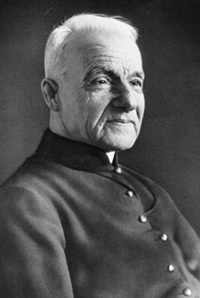
In his homily for the beatification of John Henry Newman, a month before the scheduled canonization of Blessed Brother Andre Bessette, C.S.C., Pope Benedict XVI praised the scholarly Victorian Englishman for exemplifying how “our divine Master has assigned a specific task to each one of us, a ‘definite service,’ committed uniquely to every single person.” The sanctity of Blessed Cardinal Newman, remembered not solely, but primarily, for the veritable library of elegant books, essays, poems, letters, and sermons he has left behind, provides an ironic counterpart to that of Blessed Brother André, an uneducated Quebecois who would have been incapable of reading almost anything Cardinal Newman wrote.
The “definite service” which Blessed Brother André was assigned, and which the Church, by canonizing him, insists is every bit as indispensable as Cardinal Newman’s scholarship, could not have been simpler: His service was to open the door.
Blessed Brother André is the first member of Notre Dame’s founding religious order, the Congregation of Holy Cross, to be proclaimed a saint, and his brother in Holy Cross, Notre Dame’s president, Rev. John I. Jenkins, C.S.C., will lead a delegation from the University to Rome for canonization ceremonies to be held on Sunday, October 17. Other members of the delegation will include Notre Dame provost Thomas G. Burish, Rev. James E. McDonald, C.S.C., associate vice president and counselor to the president, and Matthew Ashley, chair of Notre Dame’s theology department.
To honor Blessed Brother André Bessette and his service to the sick and needy, Notre Dame students will take up a special collection during the Oct. 16 Notre Dame-Western Michigan football game. The collection will support ongoing efforts of the University and the Congregation to help rebuild Haiti following the devastating earthquake there in January. More than 30 participants also will join in a weekend of service, prayer and learning for students, alumni, faculty and friends of the University in Rome.
Not only among the priests, sisters and brothers of the Congregation of Holy Cross, but also throughout the Notre Dame community, the new saint is affectionately regarded, conspicuously honored and continually invoked. He is routinely mentioned in campus liturgies, and his statue, carved by Rev. Anthony J. Lauck, C.S.C., is in the northeast apsidal chapel of Notre Dame’s Basilica of the Sacred Heart. Another statue of Brother André, this one carved by Notre Dame art professor Rev. James F. Flanigan, C.S.C., is above the south entrance of the University’s Eck Visitors Center.
“Blessed Brother André was famous first as a ferociously hard worker at the high school where he worked his whole life,” said Rev. David Tyson, C.S.C., Provincial Superior of the Indiana Province of Holy Cross. “He simply did everything and anything that was needed, from answering the door to cleaning the floors; from fixing shoes and doing students’ laundry to cutting hair. It seems wonderfully apt and instructive that the first Holy Cross saint was a man who insisted, sometimes testily, that ‘to serve is sweeter than to be served.’”
Born Alfred Bessette on Aug. 9, 1845, in Saint-Grégoire d’Iberville, Québec, Brother André was one of 12 children. By the time he was 12 years old, his father, a lumberman, had been killed in a work accident and his mother had died of tuberculosis. Physically diminutive, chronically ill, uneducated and clumsy with his hands, the young Bessette nevertheless worked as a farmhand, shoemaker, baker, and blacksmith in Québec for six years before leaving for New England, where he spent four years working in textile factories and farms in Connecticut, Massachusetts and Rhode Island.
From his earliest childhood, he was quietly but conspicuously prayerful, an inclination which seemed only to intensify during his hardscrabble years as an itinerant laborer, and when he returned to Canada in 1867, he confessed an interest in formal religious life to his local parish priest, who sent him to a nearby community of Holy Cross brothers with a letter assuring its superior that “I am sending you a saint.”
The largely illiterate 25-year old novice was put to work as a porter, or doorman, at Montréal’s Collège of Notre Dame, an assignment in which he continued for the next 40 years.
In addition to welcoming visitors, he served as janitor, launderer, and sacristan, ran errands and provided the students with cheap haircuts. Throughout these years his reputation for humility and kindness grew, as did the numbers of visitors he received. Most of these were poor and sick people, to whom he offered not only his compassion and what material assistance he could provide, but also moral and spiritual advice. Many of his visitors attributed miraculous cures to him, but he would insist, sometimes with annoyance, that any such cures were attributable to the prayers of Saint Joseph.
Brother André’s particular affection for St. Joseph, in addition to the need to accommodate the throngs of people seeking his help, advice and prayers, led to the foundation of Saint Joseph’s Oratory, at first a small structure constructed on Mount Royal with funds from small donations and Brother André’s barbershop income and now a massive basilica which attracts some 2 million pilgrims each year.